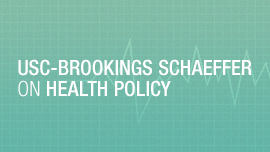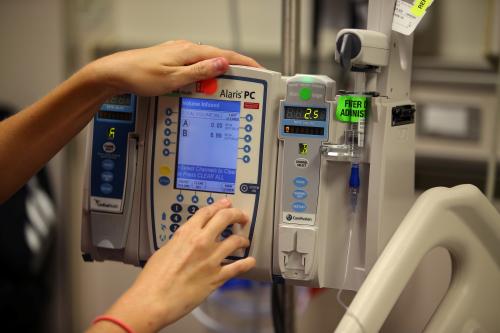What’s the latest in health policy research? The Essential Scan, produced by the USC-Brookings Schaeffer Initiative for Health Policy, aims to help keep you informed on the latest research and what it means for policymakers. If you’d like to receive the biweekly Essential Scan by email, you can sign up here.
Young Adults, Hispanics, Low-Income Individuals, and People with Less Education See Greatest Insurance Coverage Gains, 2015 to 2017
Study by: Linda J. Blumberg, John Holahan, Michael Karpman, and Caroline Elmendorf
The Urban Institute has been using the Current Population Survey to study the uninsured population in America since 2011. In the latest version of this ongoing study, the authors detail how the characteristics of the nonelderly uninsured population have changed since the last update in 2015. The authors find that the overall uninsured rate fell from 12.2 percent to 11.1 percent between 2015 and 2017. The greatest coverage gains were among individuals with lower incomes, those with less education, young adults, and Hispanics. States that had expanded their Medicaid programs saw greater coverage gains than those that did not. In order to further decrease the overall uninsured rate, the authors recommend focusing additional outreach and enrollment efforts on the 7.5 million individuals who were eligible for Medicaid or CHIP and yet had no access to affordable insurance and the 3.1 million individuals eligible for large premium tax credits and CSR payments for non-group insurance. Full study here.
Increasing Medicaid Physician Payment Rates Had No Effect on Physician Participation
Study by: Andrew W. Mulcahy, Tadeja Gracner, and Kenneth Finegold

In an attempt to further expand access to primary care for low-income individuals, the Affordable Care Act included a provision that increased payment rates for specific services delivered by primary care physicians (PCPs) to Medicaid enrollees from 2013 to 2014. This provision was meant to incentivize PCPs to accept new Medicaid patients. Although the Medicaid payment rate increases contained in the ACA were considerable– constituting a 73 percent increase in aggregate– the authors find that they had no statistically significant effect on the number of Medicaid enrollees that PCPs saw. Even when accounting for each state’s Medicaid expansion status, no significant increases in physician participation in Medicaid were observed. The authors did however find that several states experienced nontrivial increases in the number of physicians seeing at least five Medicaid patients, but the effects were not nearly as strong as previous cross-sectional studies have suggested. The authors maintain that while this attempt to use a payment rate increase to encourage PCPs to accept new Medicaid enrollees was largely unsuccessful, these results do not necessarily show that payment rates can never be an effective tool for increasing physician participation in Medicaid. They cite multiple aspects of the ACA’s Medicaid rate increase, including an onerous attestation process and the limited duration of the policy, as limitations that could be corrected in future attempts to expand access for Medicaid enrollees. Full study here.
More Black Doctors Could Help Reduce the Black-White Male Gap in Cardiovascular Mortality
Study by: Marcella Alsan, Owen Garrick, and Grant C. Graziani
African-American men have the lowest life expectancy of any major demographic group in the United States. Although there are many underlying factors that contribute to this disparity, about 60 percent of the difference in life expectancy between black and white men can be attributed to chronic diseases– which can be treated with preventive care. A new working paper examines the results of a field experiment conducted in Oakland, California, which analyzed whether the race of the doctor affects the demand for preventive care among black men. After randomly assigning black men to black and non-black male medical doctors, the researchers found that those assigned to a black doctor elect to receive the same number of preventive services as those assigned to a non-black doctor before interaction with their assigned physician. After interaction, patients assigned to black doctors increase their use of all screening services by 16 percentage points compared to those assigned to non-black doctors. The researchers point to better trust and patient-doctor communication as potential mechanisms of this change, noting patients were 10 percentage points more likely to talk with black male doctors about other health problems and black doctors were 11 percentage points more likely to write notes about black patients compared to non-black doctors. These results suggest increasing minority representation in the healthcare system would go a long way towards reducing disparities in health outcomes and life expectancy. Full study here.
Electronic Health Records Associated with Lower Hospital Mortality Once Systems Mature
Study by: Sunny C. Lin, Ashish K. Jha, and Julia Adler-Milstein
Electronic health record (EHR) adoption was promised to bring improved quality and efficiency to health care, but results thus far have been mixed-causing many hospitals and policymakers to question the value of public and private investments in EHRs. A new study uses a 100 percent sample of Medicare hospital claims from 2008 to 2013 and data on hospital IT to examine the relationship between EHR adoption and thirty-day mortality rates. The researchers quantified EHR adoption over time by using three distinct variables: each hospital’s baseline level of EHR adoption in 2008, the level of maturity of these baseline functions over time, and the rate at which hospitals adopted new EHR functions during the study period. Baseline adoption of EHR technology was associated with worse performance, with a 0.11 percentage point increase in mortality rate for every EHR function adopted in 2008. However, maturation of each baseline function was associated with a .09 percentage point decrease in mortality per year and each new function adopted per year was associated with a .21 percentage point decrease in mortality rate. The researchers also concluded that small and nonteaching hospitals received the majority of improvement in mortality rates from EHR adoption. Overall, the researchers concluded that while the adoption of new EHR functions may not lead to an immediate decrease in mortality rates, these technologies can have overwhelmingly positive effects if they are allowed to mature. Full study here.
The Brookings Institution is committed to quality, independence, and impact.
We are supported by a diverse array of funders. In line with our values and policies, each Brookings publication represents the sole views of its author(s).













Commentary
The essential scan: Top findings in health policy research
July 30, 2018